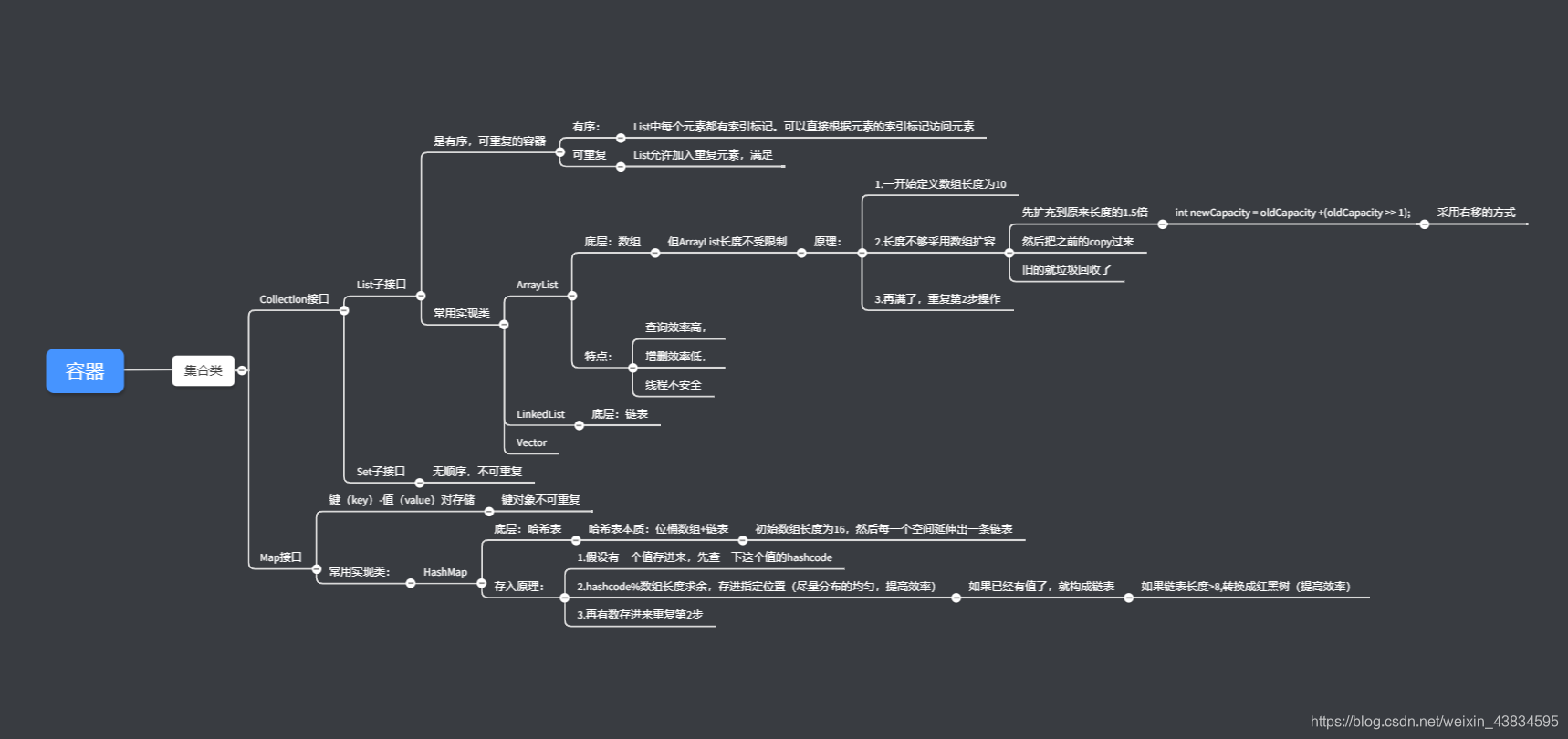老规矩先上框架图:

代码部分:
1. 测试ArrayList类的方法:
package RongQI.Collection;
import java.util.ArrayList;
import java.util.Collection;
import java.util.List;
/**
* 测试Collection接口中的方法
*/
public class TestArraylist {
public static void main(String[] args) {
test03();
}
public static void test01(){
Collection<String> c=new ArrayList();
//size()查看元素个数
System.out.println(c.size());
//isEmpty()查看是否为空
System.out.println(c.isEmpty());
//add()添加元素
c.add("高老大");
c.add("高老二");
System.out.println(c);
//remove() 把对象从容器中移出,但对像还在
c.remove("高老二");
System.out.println(c);
c.clear();
System.out.println(c);
//contains 判断是否包含的情况
System.out.println(c.contains("高老二"));
test02();
}
public static void test02(){
List<String>list01=new ArrayList<>();
list01.add("aa");
list01.add("oi");
list01.add("qwe");
List<String>list02=new ArrayList<>();
list02.add("aa");
list02.add("asd");
list02.add("zxc");
System.out.println(list01);
//addAll将另一个集合所有元素添加到另一个集合
list01.addAll(list02);
System.out.println(list01);
//一个集合去除另一个集合中相同的元素
//相当于两个集合:A-B
list01.removeAll(list02);
System.out.println(list01);
//retainAll 取交集
list01.retainAll(list02);
//containsAll如果集合A包含所有的集合B 返回TRUE
list01.containsAll(list02);
}
//测试索引相关方法
public static void test03(){
List<String>list=new ArrayList<>();
list.add("A");
list.add("B");
list.add("C");
list.add("D");
list.add("B");
System.out.println(list);
//list.add(2,"皓月当空");在指定位置插入元素,后面元素后移一位
list.add(2,"皓月当空");
System.out.println(list);
//list.remove(2); 将2位置的元素进行移出 然后后面元素都向前移动一位
list.remove(2);
System.out.println(list);
//list.set(2,"rty"); 将2处元素进行更换
list.set(2,"rty");
System.out.println(list);
//获得指定位置的元素
System.out.println(list.get(2));
//list.indexOf("B") 返回List中第一次出现指定元素的位置,没有就返回-1
System.out.println(list.indexOf("B"));
//list.lastIndexOf("B")返回list中从后向前数第一次碰到指定元素的位置
System.out.println(list.lastIndexOf("B"));
}
}
2.测试Map类方法
package RongQI.Map;
import java.util.HashMap;
import java.util.Map;
public class TestMap {
public static void main(String[] args) {
TestMap testMap=new TestMap();
testMap.testMap2();
}
public static void testMap1(){
//键值对里可以是任意对象
Map<Integer,String> m1=new HashMap();
// m1.put(1,"one"); 向m1里存键值对
m1.put(1,"one");
m1.put(2,"two");
m1.put(3,"three");
//m1.get(1)获得指定键值对
System.out.println(m1.get(1));
System.out.println(m1);
//m1.size()获得m1内键值对的个数
System.out.println(m1.size());
//m1.isEmpty() 判断m1是否为空
System.out.println(m1.isEmpty());
//m1.containsKey(2) 是否含有2这个键
System.out.println(m1.containsKey(2));
//m1.containsValue("two") 是否包含“two”这个值
System.out.println(m1.containsValue("two"));
Map<Integer,String >m2=new HashMap<>();
m2.put(3,"4");
m2.put(5,"五");
//m1.putAll(m2); 将另一个map加到第一个去
//若键重复(equals方法判断),就会覆盖前一个
m1.putAll(m2);
System.out.println(m1);
}
public void testMap2(){
Employee e1=new Employee(1001,"张三",5000);
Employee e2=new Employee(1002,"李四",7000);
Employee e3=new Employee(1003,"王五",8000);
Employee e4=new Employee(1001,"赵六",8000);
Map<Integer,Employee> map=new HashMap<>();
map.put(e1.getId(),e1);
map.put(e2.getId(),e2);
map.put(e3.getId(),e3);
//若再次存入相同的键,会覆盖上一个
map.put(e4.getId(),e4);
System.out.println(map.get(e1.getId()).getName());
System.out.println(map);
}
//雇员信息
class Employee{
private int id;
private String name;
private double salary;
public Employee(int id, String name, double salary) {
this.id = id;
this.name = name;
this.salary = salary;
}
public int getId() {
return id;
}
public void setId(int id) {
this.id = id;
}
public String getName() {
return name;
}
public void setName(String name) {
this.name = name;
}
public double getSalary() {
return salary;
}
public void setSalary(double salary) {
this.salary = salary;
}
}
}
3.HashMap的底层实现(put方法 toSring方法)
1.创建一个结点类
/*
用于SxtHashMap中
*/
public class Node2 {
int hash;
Object key;
Object value;
Node2 next;
}
2.实现
package RongQI.Map;
import javax.xml.soap.Node;
import java.util.Arrays;
/*
自定义一个HashMap
*/
public class SxtHashMap01 {
Node2[] table;//位桶数组 bucket array
int size; //存放键值对的个数
public SxtHashMap01() {
this.table =new Node2[16];//长度一定是2的整数幂
}
public void put(Object key,Object value){
//定义新的节点对象
Node2 newNode =new Node2();
newNode.hash=myHash(key.hashCode(),table.length);
newNode.key=key;
newNode.value=value;
newNode.next=null;
boolean keyRepeat =false;
Node2 temp=table[newNode.hash];
Node2 iterLast=null;
if(temp==null){
//如果节点为空,直接赋值
table[newNode.hash]=newNode;
}else{
//若不为空则尾插链表
while (temp!=null){
//判断是否有重复 ,有则覆盖
if(temp.key.equals(key)){
keyRepeat=true;
System.out.println("key重复了");
temp.value=value;//重复了覆盖value就行
break;
}else{
iterLast=temp;
temp=temp.next;
}
}
if(keyRepeat==false){
iterLast.next=newNode;
}
}
}
public int myHash(int v,int length){
return v&(length-1);
}
@Override
public String toString() {
StringBuilder sb=new StringBuilder("{");
for(int i=0;i<table.length;i++){
Node2 temp=table[i];
while (temp!=null){
sb.append(temp.key+":"+temp.value+",");
temp=temp.next;
}
}
sb.setCharAt(sb.length()-1,'}');
return sb.toString();
}
public static void main(String[] args) {
SxtHashMap01 m=new SxtHashMap01();
m.put(10,"aa");
m.put(20,"bb");
m.put(30,"cc");
m.put(40,"dd");
System.out.println(m);
}
}
版权声明:本文为weixin_43834595原创文章,遵循 CC 4.0 BY-SA 版权协议,转载请附上原文出处链接和本声明。